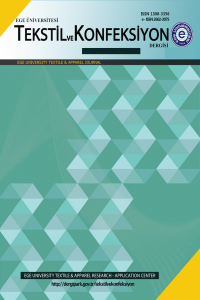PAMUK BİTKİSİNDEN ELDE EDİLEN SAK LİFLERİNİN TERBİYESİNİN OPTİMİZASYONU
PARAMETERS OPTIMIZATION FOR DEGUMMING OF COTTON-STRAW BAST FIBER
Cotton-straw bast fiber, degumming, orthogonal experimental alkali-H2O2 treatment, cellulose fiber, residual gum content, fiber fineness,
___
- 1. Gassan J., Bledzki A.K., 1997, “The Influence of Fiber Surface Treatment on the Mechanical Properties of Jute Polypropylene Composites”, Composites: Part A, Vol. 28A(12), pp. 1001-1005.
- 2. Bledzki A.K., Gassan J., 1999, “Composites Reinforced with Cellulose Based Fiber”, Progress in Polymer Science, Vol. 24(2), pp.221-274.
- 3. Gautam S, Arup C., 2008, “Dynamic Mechanical and Thermal Properties of PE-EPDM Based Jute Fiber Composites”, Journal of Applied Polymer Science, Vol. 108(6), pp.3442-3453.
- 4. Li L., Sheng G.Z., Wu L., 2008, “Development and Utilization of Cotton Bast Fibers resource”, Plant Fiber Science in China, Vol.30(4), pp.204-206.
- 5. Liu L. 2010, “Investigation on the Spinning Technology and Yarn Property of treated cotton-straw bast fibers/cotton”, Thesis of Xi’an Polytechnic University, China, pp.27-42
- 6. Jinhua W., Ramaswamy G. N., 2003, “One-Step Processing and Bleaching of Mechanically Separated Kenaf Fibers: Effects on Physical and Chemical Properties”, Textile Research Journal, Vol. 73(4), pp. 339-344.
- 7. Akin D.E., Dodd R.B., Perkins W., Henriksson G., 2000, “Spray Enzymatic Retting: A New Method for Processing Flax Fibers”, Textile Research Journal, Vol.70(6), pp.486-494.
- 8. Henriksson G., Akin D.E., Rigsby L.L., Patel N., 1997, “Influence of Chelating Agents and Mechanical Pretreatment on Enzymatic Retting of Flax”, Textile Research Journal, Vol. 67(11), pp.829-836.
- 9. Wang H.M., Postle R., Kessler R.W., 2003, “Removing Pectin and Lignin During Chemical Processing of Hemp for Textile Applications”, Textile Research Journal, Vol. 73(8),pp.664-669.
- 10. Henriksson G., Eriksson K.E.L., Akin D.E., 1998, “Chemical/Physical Retting of Flax Using Detergent and Oxalic Acid at High pH”, Textile Research Journal, Vol.68(12), pp.942-947.
- 11. Romanoschi O., Romanoschi S., Collier J.R., and Collier B.J., 1997 , “Kenaf Alkali Processing”, Cellulose Chemistry and Technology, Vol.31(5-6), pp.347-359
- 12. Hyung-Min C., 2002, “One-Bath Dyeing and Nonformaldehyde Durable Press Finishing of Cotton Using Dialdehyde and a Monochlorotriazinyl Reactive Dye”, Textile Research Journal, Vol. 72(6), pp. 469-473.
- 13. Yang S.H., 2001, “Plant Fiber Chemical”, China Light Industry Press, Beijing, China, 55
- 14. Jiang F.C., Shao K., Jiang Y., 1989, “Ramie Spinning”, Textile Industry Press, Beijing, China, 53
- 15. Qu L.J., Zhu S.F., Liu M. J., and Wang S.Y., 2005, “The Mechanism and Technology Parameters Optimization of Alkali-H2O2 One–Bath Cooking and Bleaching of Hemp”, Journal of Applied Polymer Science, Vol.97, pp.2279-2285.
- 16. Wang R.X., 1987, “Mathematical Statistic”, Xi’an Jiaotong University Press, Xi’an, China, 151
- 17. Li S.Y., 2004, “Fuzzy Mathematical and Its Application”, Harbin Polytechnic University Press, Harbin, China, 99
- ISSN: 1300-3356
- Yayın Aralığı: Yılda 4 Sayı
- Başlangıç: 1991
- Yayıncı: Ege Üniversitesi
Emine UTKUN, Ziynet ÖNDOĞAN, Mehmet YALAZ, Eser YILDIRIM SÖZMEN
ÇEŞİTLİ DOĞAL LİFLER ÜZERİNE KÖKBOYANIN EKOLOJİK BASKISI
Arif Taner ÖZGÜNEY, Pelin SEÇİM, Aslı DEMİR, Tülay GÜLÜMSER, Esen ÖZDOĞAN
KONFEKSİYON ENDÜSTRİSİNDE PERAKENDE TALEP TAHMİNLEMESİ
Özlem İpek KALAOGLU, Elif Sada AKYUZ, Sebahat ECEMİŞ, Selin Hanife ERYURUK, Halefşan SÜMEN, Fatma KALAOGLU
PAMUK BİTKİSİNDEN ELDE EDİLEN SAK LİFLERİNİN TERBİYESİNİN OPTİMİZASYONU
Long LI, Guanzhong SHENG, Qian WANG
DOKUMA KUMAŞLARIN TİTREŞIMLI BİR TARAK İLE TEFELENMESİ KOŞULLARI ÜZERİNE KARŞILAŞTIRMALI BİR ÇALIŞMA
KADIN GÖMLEĞİ DOKUMA KUMAŞ ÜRETİMİNDE DAĞILIMDAN BAĞIMSIZ KALİTE KONTROL KARTLARININ UYGULANMASI
Tuğba ÖZKAL YILDIZ, Senem ŞAHAN VAHAPLAR
Kovačević STANA, Schwarz IVANA, Brnada SNJEIANA
GİYSİLİK DOKUNMUŞ KUMAŞLARDA SEÇİLMİŞ KONFOR ÖZELLİKLERİNİN İNCELENMESİ VE TAHMİNLENMESİ
